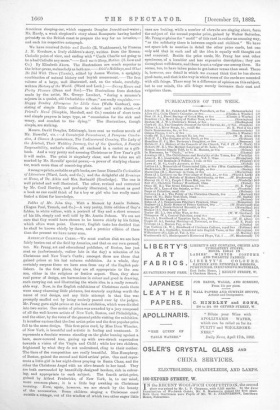AMERICAN CHRISTMAS CARDS.—Wo Must confess flit we aro here fairly
beaten out of the field by America, and that on our own ground, too. Mr. Prang, art and educational publisher, of Boston, has just sent us (unfortunately, rather late in the day) a selection of his Christmas and New Year's Cards ; amongst them are those that gained prizes at his last autumn exhibition. As a whole, they certainly surpass those we have seen from any of the English pub- lishers. In the first place, they are all appropriate to the sea- son, either in the religions or festive aspect. Then, they show real power of design, are harmonious in colour and good in drawing, each carrying out and illustrating the whole idea in a really remark- able way. Now, in the English exhibitions of Christmas cards there were many charming little pictures, but scarcely anything worth the name of real design, and any little attempt in that line was promptly snuffed out by being entirely passed over by the judges. Mr. Prang gave eight prizes at the last exhibition, which were divided into two series. One series of prizes was awarded by a jury composed of all the well-known artists of Now York, Boston, and Philadelphia ; and the other, by the votes of the general public visiting the exhibition, It is rather curious that the first artist-prize and the first popular-prize fell to the same design. This first-prize card, by Miss Dora Wheeler, of New York, is beautiful and artistic in feeling and treatment. It represents a desolate woman standing on the globe leaning against a bare, snow-covered tree, gazing up with awe-struck expectation towards a vision of the Virgin and Child ; while her two children, frightened by what they do not understand, cling to their mother. The lines of the composition arc really beautiful. Miss Humphrey, of Boston, gained the second and third artists' prize. One card repre- sents a little girl in her night-dress praying to Santa Claus, and the other the Christmas Angel with an olive-branch in her hand. They are both surrounded by beautifully-designed borders, rich in colour-
ing, and appropriate to each subject. The fourth artist.prize, gained by Alfred Fredericks, of New York, is, to our mind, more common.place ; it is a little boy awaking on Christmas morning. Here, again, however, we are struck by the beauty of the accessories. Some children singing a Christmas carol outside a cottage, out of the window of which two other eager little ones are looking, while a number of cherubs are singing above, form the subject of the second popular prize, gained by Walter Satterlee. Mr. Prang explains the" motif" of this card in rather an amusing way, "as the solidarity there is between angels and children." We have not space left to mention in detail the other prize cards, but can only add that in each and all the idea is equally well thought out and executed. Beside the prize cards, Mr. Prang has sent other specimens, of a humbler and less expensive description ; they are throughout well drawn, and there is not a vulgar one among them. He seems, too, to have taken pains to get better verses than usual. There is, however, one detail in which we .cannot think that be has shown good-taste, and that is the way in which some of the cards are mounted with silk fringe. There may be a difference of opinion on this subject, but to our minds, the silk fringe merely increases their cost and vulgarises them.

































 Previous page
Previous page